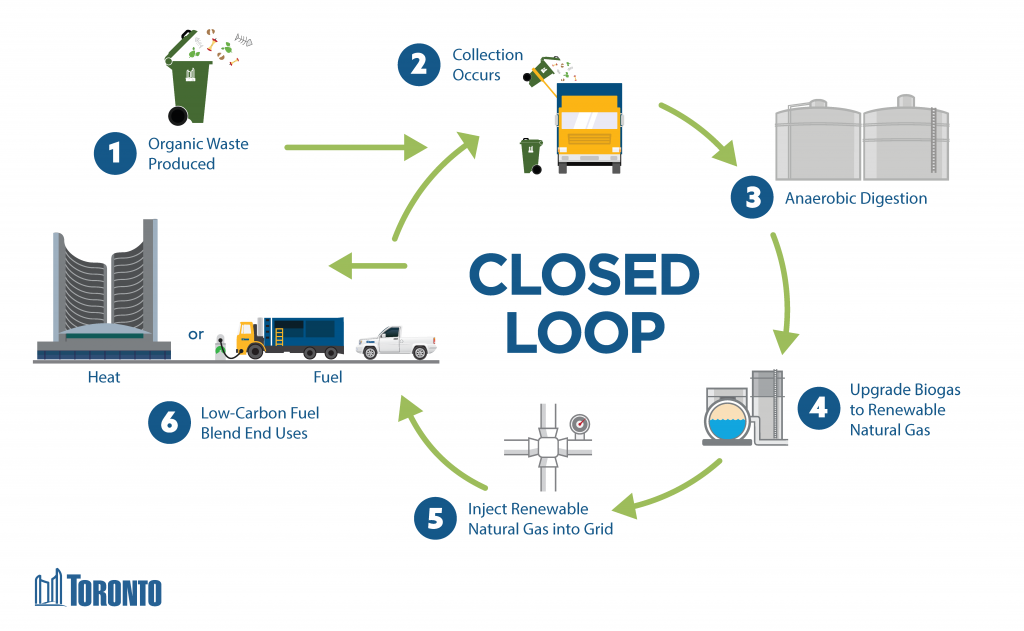
The City, working with Enbridge Gas Inc., has installed infrastructure at the Dufferin and Disco Road Solid Waste Management Facilities that allows it to create renewable natural gas (RNG) from Green Bin organics. The infrastructure enables the City to take the raw biogas produced from processing Green Bin organics, turn it into RNG and inject it into the natural gas grid for City use.
As per the strategy that was approved by City Council in 2020, the RNG produced is blended with the natural gas that the City buys to create a lower-carbon fuel blend that is used across the organization to power vehicles and heat City-owned facilities, allowing for a reduction in greenhouse gas emissions.
The City is also working to install RNG infrastructure at the active Green Lane Landfill and exploring RNG potential at the closed Keele Valley Landfill. All four sites combined would have the potential to produce enough RNG to fulfill approximately 73 per cent of the City’s entire natural gas needs annually (excluding Agencies, Boards and Corporations).
.

The City’s existing and closed landfill sites and anaerobic digestion (organics processing) facilities are some of the largest producers of biogas and landfill gas in Ontario. As a result, the City’s Solid Waste Management Services Division began exploring opportunities to harness the green energy potential of these gases.
In 2015, the Division identified RNG as a top priority for biogas management and started to search for technologies and partnerships to upgrade its biogas and landfill gas to RNG. When looking at the different technologies and options for upgrading and transporting the gas, the Division took a triple-bottom-line approach that considered the economic, social and environmental benefits.
The City has been working with Enbridge Gas Inc. to create and realize the vision for the project at the Dufferin and Disco Road Solid Waste Management Facilities and Green Lane Landfill. This includes Enbridge being responsible for the design and construction of the facilities as well as their operation and maintenance for the first 15 years.
The City currently consumes 50 million cubic metres of natural gas (NG) annually, and the City’s Agencies, Boards and Commissions (ABCs) consume an additional 60 million cubic metres of NG annually, for a combined total consumption of 110 million cubic metres annually. Incorporating RNG into the mix allows the City to create a lower-carbon fuel blend that is used to fuel City vehicles and heat City facilities. If landfill gas/biogas upgrading is realized at all four sites that the City has identified, the result would be enough renewable gas to fulfill approximately 73 per cent of the City’s entire natural gas needs annually (excluding Agencies, Boards and Corporations).
Biogas upgrading helps achieve the goals of the City’s TransformTO Net Zero Strategy, specifically the goal of becoming net zero by 2040 or sooner and the goal of generating 1.5 million gigajoules of energy from biogas by 2030. It also supports the Net Zero Carbon Plan for City Buildings and the City’s Long Term Waste Management Strategy and move toward a circular economy.
| Site | Year of completion | Estimated cubic metres of RNG/year | RNG per cent of fuel blend/year* | Carbon reduction (tonnes of C02e/year) | Gigajoules (GJ) of energy from biogas/year | Per cent of TransformTO goal of 1.5 million GJ of energy from biogas each year |
|---|---|---|---|---|---|---|
| Dufferin | 2021 | 1,871,805 | 3.7 | 5,068 | 69,444 | 4.6 |
| Disco Road | 2024 | 4,367,545 | 8.7 | 8,459 | 163,346 | 10.9 |
| Green Lane Landfill** | 2028 | 24,697,400 | 49.4 | 34,958 | 938,501 | 62.6 |
| Keele Valley Landfill** | TBD | 5,440,000 | 10.9 | 11,040 | 206,720 | 13.8 |
| All Sites | 2028 | 36,376,750 | 72.7 | 59,525 | 1,378,011 | 91.9 |
*Based on City consumption only (excludes ABCs).**It has not yet been determined how the RNG from these sites will be used.
Both biogas and landfill gas can be upgraded to create RNG. The biogas produced through anaerobic digestion is made up primarily of methane, but also includes carbon dioxide, oxygen, nitrogen, water, sulphur, and various non-methane organic compounds.
Biogas upgrading involves purifying the gas to remove carbon dioxide and other contaminants. The result is a gas that is more than 90 per cent methane and can be injected directly into natural gas pipelines.
It is common industry practice for biogas and landfill gas to be flared (burned off), however this does not take advantage of its renewable energy potential.
While chemically identical to traditional fossilized natural gas, RNG is a renewable resource that does not require mining or drilling activities.
RNG is also more environmentally friendly than fossil fuels such as diesel. Once injected into the natural gas pipeline, it can be used to fuel vehicles or provide electricity or heat.
The production of RNG from biogas/landfill gas has the environmental benefit of closing the carbon loop by capturing the gas produced (instead of flaring/burning it off), upgrading it to RNG pipeline quality and then using it to displace a fossil fuel with a renewable green fuel.
RNG generated from food waste is considered carbon neutral, if not carbon negative, because the reduction in emissions by not extracting and burning petroleum-based fuel, and the emissions avoided by not sending organics to landfill, exceed the direct emissions associated with the production and use of RNG. While compressed natural gas is 20 per cent better than diesel, RNG is 100 per cent to 120 per cent better.